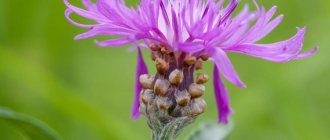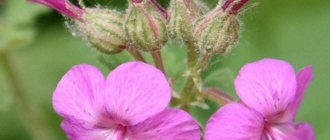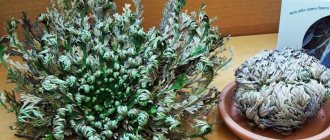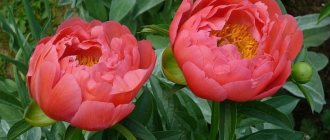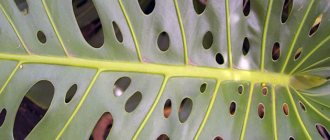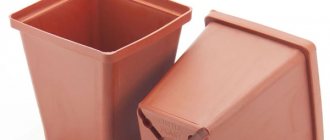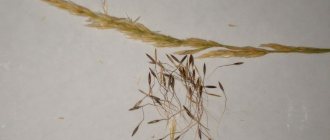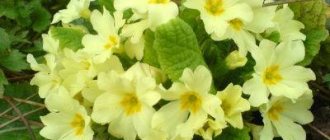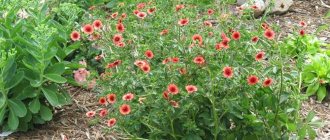Cornflower Cornflower is a magnificent representative of the Asteraceae family, which can become an...
is a magnificent representative of the Asteraceae family, which can be an ideal plant for decorating flower beds, balconies and gardens. Anyone who has ever seen a blooming cornflowerCornflower is a magnificent representative of the Asteraceae family, which can become an id..., was probably fascinated by its beauty.
Blue or field cornflowerCornflower is a magnificent representative of the Asteraceae family, which can become id..., was revered in Rus' as a flower symbolizing devotion and innocence. A representative of the Asteraceae, it attracts attention with its tenderness and brightness. Since the 60s, cornflowerCornflower is a magnificent member of the Asteraceae family, which can become the id... blue has been named the national plant of the Estonians.
Cornflower Cornflower is a magnificent representative of the Asteraceae family, which can become an ideal... blue is often present as a bright “guest” in city flower beds and flower gardens, and thanks to its medicinal properties, it was recognized as a medicinal plant and included in the book of medicinal herbs.
Cornflower blue description
Cornflower Cornflower is a magnificent representative of the Asteraceae family, which can become i..., found among meadow grasses, belongs to the representatives of the Asteraceae, a group of Asteraceae. In common people, the plant was called blue flower, rye flower, hairy flower, and blue flower. Thanks to its rapid growth rate and unpretentiousness, cornflowerCornflower is a magnificent representative of the Asteraceae family, which can become i... settled far beyond the borders of its homeland.
Among the cornflower variety there are perennial and annual varieties. Perennial plants withstand bad weather, cold, and drought more steadfastly; flowers of this type grow quickly, get along with all types of plants and sometimes some survive from the site.
Cornflower Cornflower is a magnificent representative of the Asteraceae family, which can become an i... blue one, is little susceptible to disease, reproduces without problems, blooms for a long time, and therefore is so loved by gardeners. Throughout the growing season, the leaves of cornflowerCornflower is a magnificent representative of the Asteraceae family, which can become i... remain green, in the fall, with proper care, the plant can turn green again, and even delight you with flowers.
The stem of the plant is thin, erect, and prone to lodging, like all meadow plants. Flowering is long, the first from May to June, and with proper care, it blooms again in August, with bright blue flowers.
After flowering, it forms a small seed box, which must be removed in time to avoid the flower turning into an annoying weed.
It is customary to cut the seed pod until it cracks; if necessary, the seeds are removed and dried.
Blue cornflowerCornflower is a magnificent representative of the Asteraceae family, which can become an... often found as a weed in fields sown with rye. Cultivated rye is an annual (biennial) herbaceous plant of the Evil family..., thanks to the long and strong root system, the flower grows quite long and is capable of endure any weather changes.
Growing quickly, it can completely clog a cereal crop, so the plant is an undesirable guest in the fields.
Shades of cornflowerCornflower is a magnificent representative of the Asteraceae family, which can become i... blue varies from dark blue to purple, the stem of the plant is thin but long, reaching a meter in height. The plant bears fruit with asteraceous fruits, a tufted oblong achene, and oval shape.
Composition of cornflower flowersCornflower is a magnificent representative of the Asteraceae family, which can become i... includes a glycoside, cyanogenic and pigment, these substances are mildly toxic, therefore, when using the plant for medicinal purposes, you must clearly know the dosage and its contraindications.
The rich color of cornflowerCornflower is a magnificent representative of the Asteraceae family, which can become an id... received due to the presence of anthocyanin in the composition, this element has antioxidant properties.
In addition to the above, cornflowerCornflower is a magnificent representative of the Asteraceae family, which can become i... blue is rich in organic acids, resins, alkaloids, tannins, B vitamins, retinol, esters, phenols and flavones.
Types of cornflower
| View | Description / Height (cm) | Leaves | Flowers |
| Blue | The stem is straight, branched. One- or two-year-old grass. 20-80. | Different: the lower ones with a petiole, the upper ones without a petiole, whole-edged. | Collected in inflorescences - baskets. The color is blue and blue. |
| White | Perennial. Protected species. Up to 30. | Thin, elongated, lanceolate. | Terry. Baskets in size 4 cm. |
| Mountain | Upright plant. 70. | Whole-edged, lanceolate, smoky green. | 7-8 cm in size, the central tubular flowers are lilac or bright pink. On the periphery - false blue or cyan. |
| Yellow | Perennial. Branched thick cylindrical stem. Up to 100. | Lanceolate. | Yellow, 5 cm in diameter. |
| Large-headed | Perennial with a branched stem. Up to 120. | Rough, lanceolate, dissected. | Gold, 7 cm in diameter. The receptacle is covered with small scales |
| Oriental | Wild perennial. 80 – 120. | With petiole, pinnate - separated. | With a strongly overgrown receptacle, covered with large scales. Yellow. |
| Lugovoy | Perennial with ribbed, rigid stems. The entire plant is covered with small silvery fibers. 80. | The lower ones have a petiole. The upper ones are without it, lanceolate. The next location on the stem. | False flowers are large. Lilac-pink. |
| Field | Annual. 50. | Narrow and long, lanceolate, gray-green. Plants with a solid edge at the top, lobed at the bottom. | Shades of blue and blue. |
| Whitened | Perennial with branching stems. Up to 60. | The lower ones have petioles, dissected, with whitish pubescence, the upper ones are green, sessile with a lobed or dissected edge | False ones are purple, tubular ones are white or pale pink |
| Spreading | Spreading biennial plant. The hairs give a grayish tint. 20-50. | The upper ones have a single leaf blade, the middle ones are dissected, the lower ones are double dissected. | Small, up to 5 mm in diameter. Pink, light purple, white. |
| Pink | Perennial, erect stem, strongly overgrown receptacle. Up to 100. | Lanceolate, dimly green in color. | Pink, 5 cm. |
Where is it used and are there any contraindications?
Dried cornflower flowers are often used for medicinal purposes. Cornflower is a magnificent representative of the Asteraceae family, which can become an ideal... Homeopaths use cornflower raw materialCornflower is a magnificent representative of the Asteraceae family, which can turn blue, for the preparation of diuretic infusions, infusions and anti-inflammatory herbal teas.
Cornflower blue decoction is recommended for eliminating edema, improving diuresis, for heart ailments, urinary tract diseases, cystitis, urethritis and for the treatment of the prostate.
Infusion of cornflowerCornflower is a magnificent representative of the Asteraceae family, which can become i... blue. It regulates the water-salt balance in the body, eliminates the first signs of disorders of the gastrointestinal tract, washes sand from the kidneys, has a choleretic, anti-inflammatory effect and a slight analgesic effect.
Cornflower decoctions have antispasmodic and mild sedative effects. Cornflower Cornflower is a magnificent representative of the Asteraceae family, which can become an ideal... used for cholecystitis, liver diseases, metabolic disorders in the body, cholangitis and diseases of the nasopharynx.
Cornflower Cornflower is a magnificent representative of the Asteraceae family, which can become an ideal... often found in anti-inflammatory and diuretic preparations, containing bearberry, licorice root and ginger. Cornflower infusion is taken according to Art. l. up to 4 times a day, on an empty stomach.
Cornflower decoctionCornflower is a magnificent representative of the Asteraceae family, which can become an ideal... used in cosmetology, lotions are prepared from the plant, the extract and esters are included in the composition of creams, moisturizing and soothing pastes for facial care. Frozen cube of cornflower decoctionCornflower is a magnificent representative of the Asteraceae family, which can become an ideal... tones the skin, fights increased oiliness, irritation, redness, enlarged pores and eliminates acne.
Thanks to its antibacterial and disinfecting effects, herbalists use cornflower infusions. Cornflower is an excellent representative of the Asteraceae family, which can become an ideal... in the treatment of eyes and respiratory infections.
The plant is also used to rinse hair; the flower stimulates hair growth, nourishes the roots, and relieves dandruff and itching. In combination with a decoction of nettle and burdock, cornflowerCornflower is a magnificent representative of the Asteraceae family, which can become an ideal... blue fights alopecia, makes hair strong, thick and shiny.
Cosmetology actively uses cosmetic preparations based on cornflowerCornflower is an excellent representative of the Asteraceae family, which can become an ideal... to eliminate blue circles, swelling, excessive puffiness under the eyes, and lotions with a decoction of cornflowerCornflower is an excellent representative of the Asteraceae family, which can become an ideal... blue to eliminate irritation and redness of the eyes.
Alcohol tincture of cornflowerCornflower is a magnificent representative of the Asteraceae family, which can become an ideal..., in a totem with celandine, it fights fungal skin infections, ulcers, eczema, and also helps speed up the healing process of wounds and abrasions. Cornflower Cornflower is a magnificent representative of the Asteraceae family, which can become... blue also has hemostatic properties, it is used during uterine blood loss. Rinsing with a decoction of cornflowerCornflower is a magnificent representative of the Asteraceae family, which can become id... and oak bark, will eliminate gum disease and bleeding.
Like all medicinal herbs, cornflowerCornflower is a magnificent representative of the Asteraceae family, which can become id...blue has its own contraindications. The flower is contraindicated for pregnant women and nursing mothers, as it is mildly toxic and affects blood clotting. During pregnancy, cyanide, contained in large quantities in cornflower, Cornflower is a magnificent representative of the Asteraceae family, which can become i..., are able to penetrate the placental barrier and negatively affect the fetus.
In addition to expectant mothers, persons with individual intolerance and allergy sufferers should not take medicinal infusions of cornflower. Cornflower is a magnificent representative of the Asteraceae family, which can become i..., without consulting a doctor. People with high blood clotting and open stomach ulcers should also refrain from treatment with herbal decoctions.
Medicines, method of use of blue cornflower and dose
- Blue cornflower flowers (Flores Centaureae cyani) are available in packages of 100 g. Store in a cool, dry place.
- Infusion of blue cornflower flowers (Infusum florum Centaureae cyani): 1 tablespoon of the raw material is placed in an enamel bowl, poured with 200 ml of hot boiled water, covered with a lid and heated in boiling water (in a water bath) for 15 minutes. Cool at room temperature for 45 minutes, filter, and squeeze out the remaining raw material. The volume of the resulting infusion is adjusted to 200 ml with boiled water. The prepared infusion is stored in a cool place for no more than 2 days. Take 1 tablespoon warm 3 times a day as a mild diuretic, choleretic and antimicrobial agent.
- For external use: scald fresh herbs with boiling water, and heat dry herbs for 15 minutes in a water bath, then wrap all the raw materials in several layers of gauze and apply to the affected area.
- Recipes for single use of blue cornflower in medicine
ATTENTION! Infusions and decoctions of cornflower are slightly poisonous. Pregnant women should not take!
Contraindications and possible side effects of blue cornflower.
Due to the plant containing highly active compounds with a cyanogen component, it is necessary to be careful in its use.
Animals generally do not eat this plant.
Its presence in large quantities in hay can cause respiratory diseases in horses and cattle.
Coarse fibers of blue cornflower can cause intestinal catarrh in horses.
Growing
Growing and planting cornflowerCornflower is a magnificent representative of the Asteraceae family, which can become an... not a difficult task. As already mentioned, the wild “blue flower” is mostly a weed, so it does not require painstaking care, has excellent survival rate and can withstand bad weather.
However, if you want to achieve several blooms per season and large inflorescences, you need to know some of the subtleties of planting cornflower. Cornflower is a magnificent member of the Asteraceae family, which can turn id... blue.
First, decide on the planting site, cornflowerCornflower is a magnificent representative of the Asteraceae family, which can become an i... loves sunny and windless areas, because with a lack of sun it stretches upward, its flowers become smaller, and in strong winds it is prone to lodging. Therefore, choose sunny, windless areas.
The only requirement for soil is that the soil is not swampy and fertile. If you plan to plant several different plants to form a composition, then the first rows should belong to cornflowers. Cornflower is a magnificent representative of the Asteraceae family, which can become an ideal... so that the shadow from other plants does not fall on them. The only variety of cornflowerCornflower is a magnificent representative of the Asteraceae family, which can become id... blue, which is able to tolerate shade can be called “cornflowerCornflower is a magnificent representative of the Asteraceae family, which can become id... soft,” but it will also suffer from a lack of sunlight and become smaller year after year.
Planting blue cornflowerCornflower is a magnificent representative of the Asteraceae family, which can become an ideal... you can do it in a row, or in a checkerboard pattern, or in pots, the main thing is to give each specimen plenty of space. If you intend to plant the plant in rows, then follow the “step” of at least 45 cm between flowers.
Proper planting and adherence to agricultural technology will give you a plant that is not only healthy, but also healing. Indeed, on fertile soils and with good care, the plant fully reveals its medicinal potential, accumulates valuable microelements and retains them.
Purchased cornflower seedsCornflower is an excellent representative of the Asteraceae family, which can become id...blue, it is better to sow it in the spring, when the earth has warmed up enough, sowing in beds about 2 cm deep, without thickening. The first shoots will appear within a week; it is better to thin out densely growing seedlings immediately.
If you are planting cornflower seedlings, then plant them in holes no more than 10 cm deep, based on the size and length of the roots (the soil should completely cover them, covering three centimeters of the stem).
Keep the distance between seedlings in increments of 30-40 cm.
Flowers are propagated by seed; after flowering, the cornflower is a magnificent representative of the Asteraceae family, which can become... a seed pod is formed, which, after ripening, will be ready to give you new seeds for planting.
The unpretentiousness of the plant makes it possible for even beginners and inexperienced gardeners to grow it, and its endurance and vitality will save you from painstaking care. Cornflower Cornflower is a magnificent representative of the Asteraceae family, which can become an ideal... blooms for a long time and fits perfectly into any landscape, giving it brightness and airiness. And thanks to its ability to survive, the plant is suitable for absolutely any planting, both in open ground and in greenhouse conditions.
Growing conditions.
Growing cornflower is very easy. This unpretentious, long-flowering plant is best sown in well-lit areas in early spring.
Grows well in poor, sandy soils.
Reproduction
Cornflower propagates by seeds; freshly collected seeds have low germination rate. Therefore, it is better to sow them after storing them in a dry place for a year. Both winter and spring sowing are effective.
Seeds are planted to a depth of 2-3 cm. The distance between rows is 20-30 cm. Shoots appear in 5-7 days. The seeds are collected as the inflorescences fade, cleaned and sown the next year. It is better to store cornflower seeds for no more than 2 years; with longer storage they lose their viability.
Advice. It is best to place the plant in a mixed border or on a border along the path. Dwarf forms are suitable for this purpose. But for medicinal purposes, you should not plant forms with white flowers. Their medicinal effect will be half-hearted due to the lack of anthocyanins.
cornflower
Care
Care consists only of weeding and loosening. It doesn't even need feeding.
Chemical composition
Only the marginal bright blue flowers, which contain anthocyanins, coumarins, polyacetylenides, glycosides, and alkaloids, have healing properties.
Active ingredients
The marginal flowers of cornflower contain anthocyanins and coumarins. The most common anthocyanins are centaurin and the coloring matter cyanine, and the coumarins are cichoriin. In addition, triterpenoids, sterols, polyacetylene compounds, phenolcarboxylic acids (chlorogenic and caffeic) and their derivatives, tannins were discovered.
Caring for cornflower crops
The flower is unpretentious, adapts perfectly to any climatic latitudes and grows on different soils, sometimes unsuitable for flowering crops. Winter period for cornflowersCornflower is a magnificent representative of the Asteraceae family, which can become... not scary (the plant is frost-resistant), and flowering can please the eye from May to July.
The plant does not need hilling, treatment or protection from insects, and there is no need for frequent weeding either. The flower is not susceptible to disease. For such durability, cornflowerCornflower is a magnificent representative of the Asteraceae family, which can become i... blue was recognized by many gardeners as a “win-win” floriculture crop, which everyone can grow.
Light, warmth and moist soil, these are the three postulates that must be observed when planting cornflower. Cornflower is a magnificent representative of the Asteraceae family, which can become an ideal... A warm, sunny area and regular watering are all the conditions for favorable growth and flowering.
For abundant flowering and large buds, cornflowerCornflower is an excellent representative of the Asteraceae family, which can become i... you should feed it during the spring awakening and make sure that at the early stage of the plant’s growing season there are no weeds nearby. Any mineral or organic fertilizer is suitable as a top dressing.
To develop a strong root system, especially on heavy clay soils, cornflowerCornflower is an excellent representative of the Asteraceae family, which can become an ideal... loosening, which should be carried out at least once a week, will not hurt.
Pruning and shaping the plant is not required, but is not prohibited. After the end of flowering, dried flowers should still be torn off so as not to spoil the overall appearance. A species is an evolutionarily developed set of individuals, characterized by a single ... flower bed.
Perennial cornflowersCornflower is a magnificent representative of the Asteraceae family, which can become i... they bloom without replanting for more than 5 seasons and do not become smaller; they bear fruit from the second year of the growing season. Reproduction of cornflowersCornflower is a magnificent representative of the Asteraceae family, which can become an id... perhaps by seed and by dividing the bush.
After the completion of the flowering cycle, in the fall, cornflowersCornflower is a magnificent representative of the Asteraceae family, which can become i... it is better to prune at the root so as not to infect the root system with a putrefactive infection or fungus.
Cornflowers flowers: cultivation
Since the flower is an annual plant, it can be planted using the seedless method, that is, the seeds are sown directly into the ground. Planting is done at the end of April or at the beginning of May, choosing well-lit, sunny places. The flower prefers non-acidic, loose, sandy loam soil, where there is enough light and good watering. If alkaline soil is used, then the growing of plants will be more intensive, and the flowers themselves will become bright and large. If the site has clay soil, then it is advisable to add sand to it, which will make it more loose. Acidic soil is mixed with lime, which must be done before the first frost.
Before growing cornflowers in the garden from seeds, you need to prepare the beds in advance. First, mix two kilograms of peat and humus and add a little ash and nitrophoska. Then the beds are carefully dug up and the soil is leveled, after which it is necessary to make small grooves for planting seeds. The top of the beds is sprinkled with a thin layer of soil and watered abundantly. After this, the soil is carefully compacted, and the bed itself is covered with fabric to create a greenhouse effect. When creating a flower arrangement, the beds are formed in such a way that there is no shadow from the flowers on smaller plants.
When planting cornflowers: growing them requires abundant watering, especially in hot summers. The distance between the bushes should be about 40 cm. Water the sown seeds every 2-3 days. On average, about 2 liters of water are consumed per square meter of land. Cornflowers sprout within one to two weeks after planting the seeds. In order for the plants to be healthy and strong, they are thinned out, leaving at least 10 cm between young bushes. Plants are grown in beds, pots or fields, since the medicinal properties of cornflower flowers are used in medicine and cosmetology. Planting material remains viable for 2-3 years.
Properties of blue cornflower
The plant has become famous for its high content of cyanidin, pelargonidin, anocyanins, flavonoids, luteolin, kaempferol, astragalin, mineral salts, saponins, bitterness, alkaloids, ascorbic acid and pectin. All of these substances have a significant spectrum of antibacterial and diuretic effects.
Pharmaceutical and cosmetology companies have long included hairweed in the list of popular herbs and use it as a single raw material for the manufacture of medicines, and as part of “compounded” teas.
The main raw materials for harvesting are flowers and the peduncle of the plant. During harvesting - cornflower flowersCornflower is a magnificent representative of the Asteraceae family, which can become... cut, dried, and only then used for its intended purpose.
Medicinal raw materials, if properly dried, can be stored for up to six months in a dry, dark place.
Voloshka, a strong diuretic, is therefore primarily used for the treatment of genitourinary diseases. During research, it was found that medications based on cornflowerCornflower is an excellent representative of the Asteraceae family, which can become i... blue, relieve spasms, have a diuretic effect, reduce the concentration of uric acid in the body, have an antibacterial and choleretic effect, normalize kidney function and relieve inflammation, and due to the high content of bitterness in the raw material, the functioning of the gastrointestinal tract is normalized.
Cornflower Cornflower is a magnificent representative of the Asteraceae family, which can become an ideal... blue is not only a beautiful plant that can add brightness and airiness to your area, but also an excellent medicine for many ailments.
Cornflower in the garden
Prefers free planting, a distance between plants of at least 25 cm and a sunny place. The soil needs to be fertile and neutral in acidity. On soils rich in lime, the flower shows more vibrant color. Watering is moderate, does not tolerate waterlogging.
When combined with other flowers, cornflower is planted in front so that the sun's rays evenly illuminate the leaves.
What it looks like and where it grows
Cornflower is easy to identify in the field by its rich blue flower. This is an annual plant with a slender stem. The height rarely exceeds 70 cm, the usual size for field cornflower is 30–50 cm. The leaves are trifoliate, weakly expressed, and die off by the time of flowering.
The flower has a formed basket around which there are blue petals. The outer leaves are valued in medicine; they have a unique five-toothed shape. Active flowering window is June-July.
Blue cornflower grows throughout Russia and Europe, except for the Far North and arid regions. The plant prefers sandy soils. It can be found in any field of rye, oats or flax. It also grows well in meadows and fallow fields.
Kinds
More than 500 species of cornflower have been registered, of which 184 grow in Russia. Most of them have no particular medicinal or culinary value. Farmers fight the flower as a weed in their fields. Ruminant animals can eat it without any consequences.
Among the species common in Russia, rough and meadow ones should be highlighted - they are excellent honey plants and are used to a limited extent in folk medicine. The most valuable is blue or field cornflower. It is used in cooking, winter preparations and is included in various medical preparations.
Other common types of cornflowers have only decorative value and can be used to a limited extent as honey plants or used to feed ruminants.
Collection and storage
For medicinal purposes, only bright blue cornflower petals are used. They are picked from funnel-shaped flowers that are in the active flowering stage. The best time is June-July, occasionally early August. Then the content of nutrients in the petals declines. Cooking also values cornflower seeds; they are harvested closer to mid-August.
There are several collection technologies. The ancient one is more gentle for the plant. Only the outermost, most beautiful and bright blue leaves are torn off by hand. The flower itself is not damaged. New industrial technology requires picking or cutting flower baskets, and then separating the blue petals from them and discarding the white corollas. Raw materials collected using this technology are sold in pharmacies as cornflower extracts and teas.
Drying of the plucked petals is carried out at a temperature of 40–50 degrees. Beneficial glycosides can begin to break down when exposed to prolonged, dry, high temperatures. Today, artificial dryers are widely used. However, you can also use the old proven method, laying the raw materials on paper in a thin layer in a well-ventilated room.
Dried cornflowers can be stored for up to a year. However, it is necessary to keep the raw materials in a dark place, since sunlight will lead to the breakdown of cyanine and other active substances. This can be determined visually - spoiled dried petals turn white.
Medicinal herbal collections use
For diseases of the kidneys and urinary tract , especially with edema of renal and cardiac origin:
- cornflower flowers - 3 parts
- angelica root - 3
- juniper fruits — 4
One table. l. pour 2 cups of boiling water over the mixture and leave for 20 minutes. Take 3-4 times a day, 1/4 cup as a diuretic. Store the infusion in the refrigerator for no more than two days;
- cornflower flowers - 1 part
- bearberry leaves - 3
- licorice root - 1
One table. l. pour a glass of boiling water over the collection and leave for 30 minutes. Take 1/4 cup 3 - 4 times a day 15 - 20 minutes before meals as a diuretic and anti-inflammatory agent.
Decoction for washing eyes with eyebright:
- 1 tsp. cornflower flowers,
- 1 tsp. eyebrights,
Pour two teaspoons of the mixture into a glass of boiling water, boil for 2-3 minutes. over low heat under a lid, cool, strain, filter through cotton wool. Place 2-3 drops into the eyes and rinse the eyes with this infusion 3-4 times a day.
Baths with a decoction of herbs with petals are used for diathesis in children, baths are used topically for joint diseases.
Contraindications
- Hypersensitivity, individual intolerance to drugs.
- Cornflower preparations are contraindicated to be taken orally during pregnancy.
Before taking medications, consult your doctor.
Watch the video:
The flowers produce thick greenish-amber honey with a pleasant almond smell; it is a good honey plant.
The tubular flowers of the plant can be used to produce blue dye.
Use in cooking
In addition to its pronounced medicinal properties, cornflower is widely used in traditional cuisine. The flowers and seeds of the plant are used, dried and crushed. The seasoning in powder form can occasionally be seen in supermarkets; cornflower is often included in various mixtures for pickles, soups or meat.
The preparations can be well diversified with the help of petals and cornflower seed powder. They impart a subtle mint-lemon aroma and improve the preservation of pickles. The recipe is extremely simple, you should add 10-15 g of powder and 2 teaspoons of petals to a three-liter jar of canned vegetables.
Cornflower leaves have a subtle but expressive taste, something between lemon, mint and cloves. The seeds are a bit like red chili peppers, but with a slight minty flavor. This combination goes well with a universal sauce for rice, mashed potatoes and meat dishes.
Sauce
For cooking you need the following products:
- beef or chicken broth - 2 tablespoons;
- grated tomatoes – 1 tablespoon;
- butter – 15 g;
- dried cornflower flowers – 1 teaspoon.
It is better to use natural broth, but you can make it from a cube. This also applies to tomatoes; if there are no fresh ones, then it is permissible to take boiled canned ones from a jar. All ingredients must be heated in a container and mixed until smooth. If the sauce is made for meat, then it is good to add a little rosemary.
Salad
A spring salad that charges you with vigor and strength - it also cannot do without cornflower. To prepare it you need:
- fresh dandelion leaves – 50 g;
- fresh dill – 10 g;
- hare cabbage – 50 g;
- borage or borage – 100 g;
- sour cream 20% fat – 25 g;
- cornflower seed powder – 10 g.
Soak the leaves in a bowl of water and leave for 15-20 minutes. Then let the liquid drain and chop finely. Mix everything in a dish or bowl, add cornflower seed powder and sour cream. Use other seasonings and salt to taste. Green onions or early radishes go well with the salad. But these are not required ingredients of the dish.
Vegetable side dish
A healthy vegetable side dish can be prepared quickly. The following components will be required:
- beets – 250 g;
- flour – 50 g;
- vegetable oil – 30 g;
- dried cornflower flowers – 10 g;
- citric acid – 2–3 g;
- salt, pepper and other seasonings - optional.
The beets must be boiled until tender, right in the peel, as is done for salads. Then peel the cooled vegetable and chop it on a coarse grater. Pour half of the vegetable oil prepared for the recipe into a frying pan and fry the flour until golden. Now add grated beets, cornflower flowers, citric acid, spices, about 100 ml of water and the rest of the oil. Simmer covered over low heat for 10–15 minutes.
Borsch
You can also cook unusual borscht, which is very tasty and healthy. Required:
- meat broth – 500 ml;
- white cabbage – 100 g;
- onion – 1 pc.;
- beets – 50 g;
- potatoes – 2 pcs.;
- carrot – 1 pc.;
- boiled egg – 1 pc.;
- classic tomato sauce – 1 tablespoon;
- sour cream 20% fat – 25 g;
- dried blue cornflower petals – 15 g;
- spices, herbs - optional.
Borscht is prepared in a classic way, according to your favorite recipe. The differences begin at the final stage of preparation. Part of the onion must be sautéed and left like tomato paste. Add them 10 minutes before readiness, along with cornflower and spices. If greens are used, they should be added after another 5 minutes. Already to serve, add sour cream and a cut boiled egg to the plate. This borscht turns out to be extremely tasty and healthy.
Place for growing cornflower
Cornflowers love well-lit and spacious areas, but also grow well in partial shade. In gardens they are used to create meadow-style landscapes, well suited for lawns, alpine slides or border design. Universal, fits into any flower beds. Combinations of cornflowers of different shades look great: dark blue, yellow and pink. Often planted in an ensemble with calendula, adonis, and cosmos.
